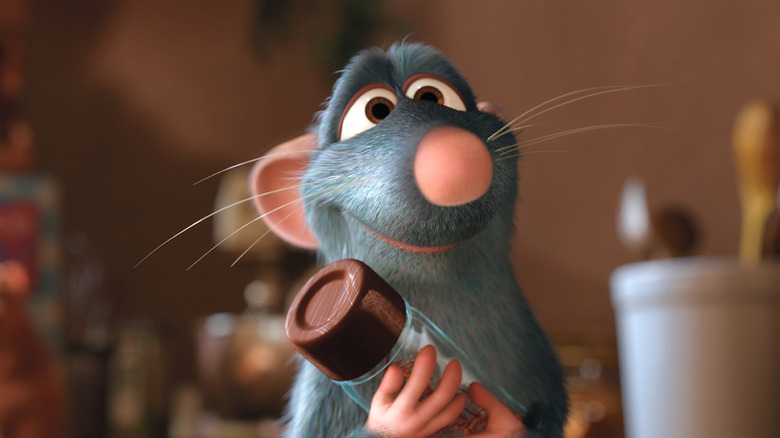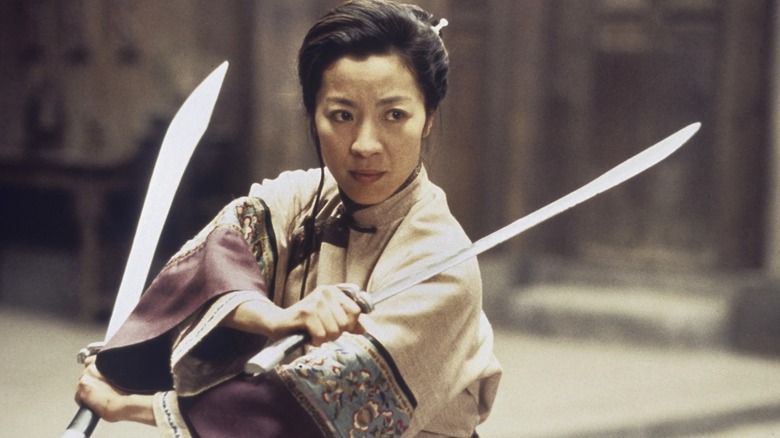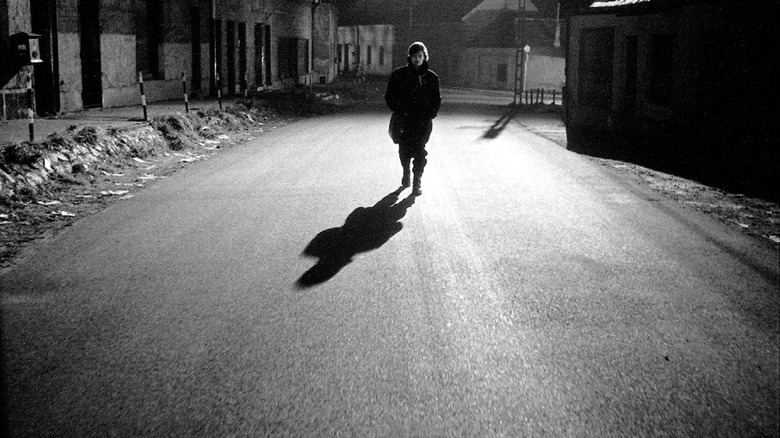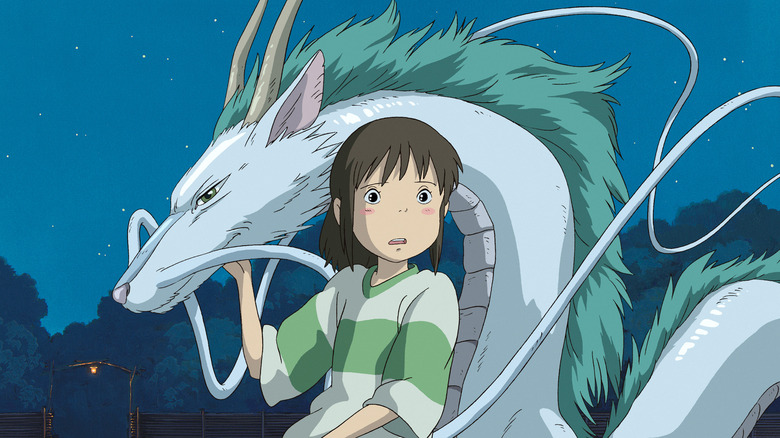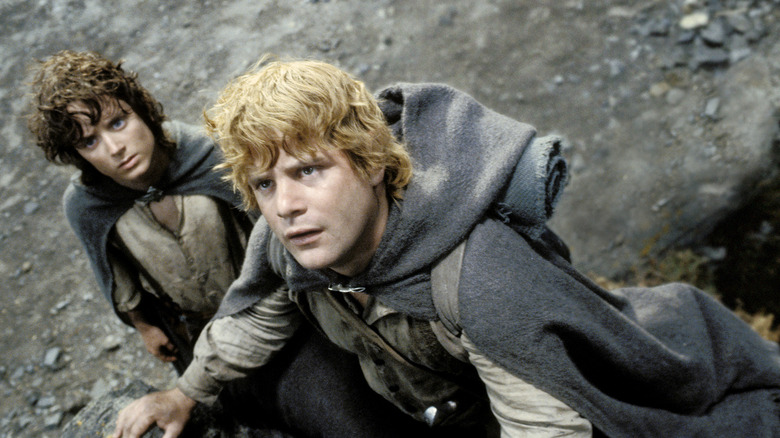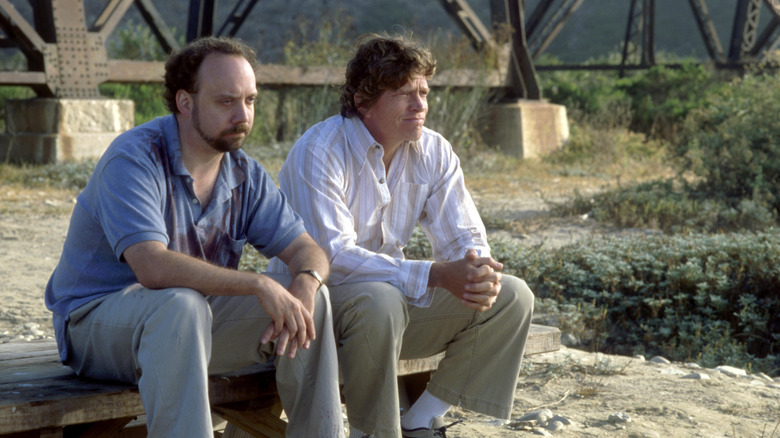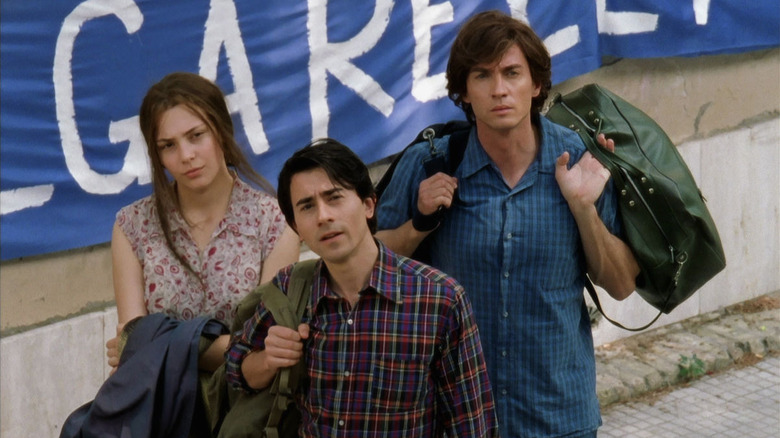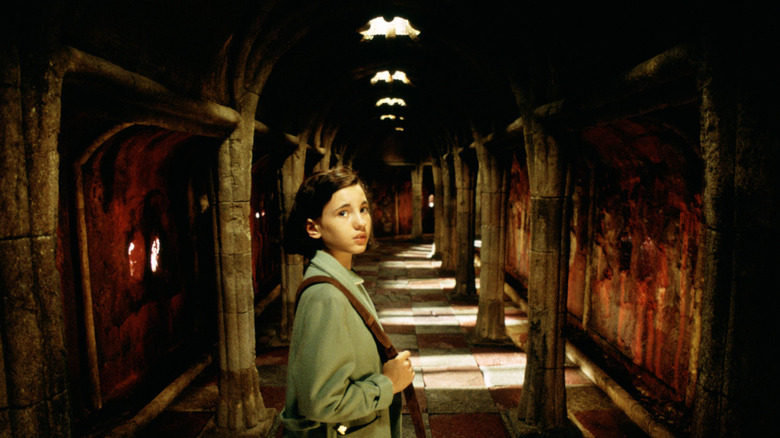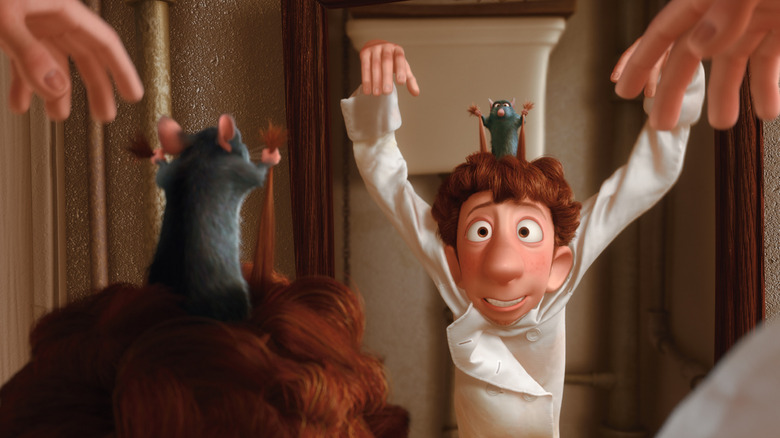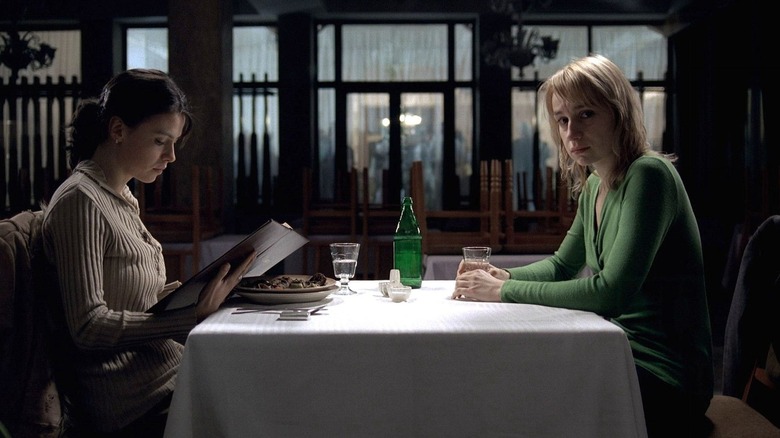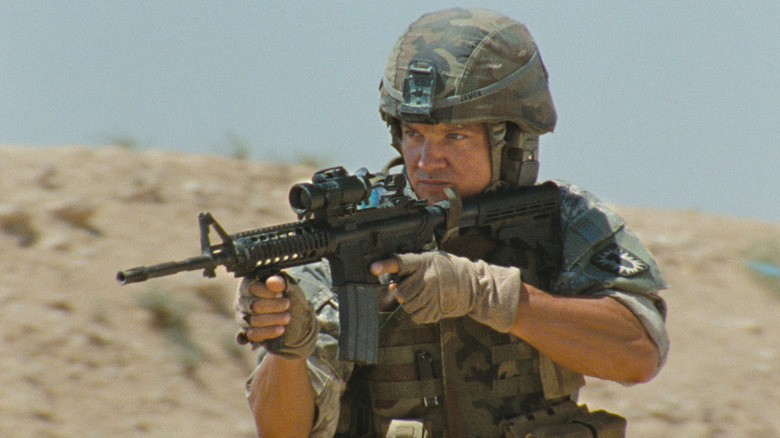The 10 Best Movies Of The 2000s
No matter how dire things get in the real world, artists keep using the medium of cinema to produce works of art that resonate profoundly with people. Just look at the 15 best movies of 2024 for a recent example of this phenomenon. This was just as true as ever in the 2000s, the 21st century's first decade. At the dawn of a new era in human history, it was easy to question what exactly a fresh epoch of cinematic storytelling would look like. Countless Earth-shattering geopolitical events scattered across these ten years only made the future of movies ever trickier to navigate and comprehend. However, the most acclaimed flicks of the 2000s kept providing hope in the middle of all the instability. "Great art can come from anywhere," after all, as one of the decade's finest films would observe.
Inevitably, when one is dealing with an entire decade of cinema history, the best-reviewed movies of the 2000s vary wildly in tone and style. Some are mainstream American films built by gigantic studios to make piles of money. Others are obscure entities from foreign countries that shatter the conventions of how motion pictures are "supposed" to look. Some of these titles are bright and cheerful, others are unflinching in examining the darkest underbellies of the modern world. Certain titles from this era, like the biggest summer movies of the 2000s, are well-known now for their monetary achievements. The 2000's most acclaimed movies, though, have endured for far more important reasons.
2000: Crouching Tiger, Hidden Dragon
There were martial arts movies before "Crouching Tiger, Hidden Dragon" and there were martial arts movies after this 2000 Ang Lee directorial effort took the world by storm, but never before had combat between two people been rendered like this on-screen, like angels pirouetting across the sky. There was a delicate beauty to hand-to-hand skirmishes in Lee's hands that, when combined with iconic performances (from the likes of Chow Yun-fat and Michelle Yeoh) and an emotionally rich story, produced something people couldn't stop talking about. "Crouching Tiger" was a firmly classical story in many respects, yet its visual and pathos achievements made it feel so brand new. That was a combination critics and audiences alike couldn't resist.
Not only was "Crouching Tiger, Hidden Dragon" by far the best-reviewed movie of 2000, but critics were in awe of how it worked so well on so many different levels. Here was a motion picture that delivered such stunning and absorbing intimate drama, yet it also had the kind of action spectacle no other film delivered. It was the perfect blend between Lee's intimate and grandiose impulses that later features (such as "Billy Lynn's Long Halftime Walk") would struggle to execute. Back in 2000, though, the accomplishments of "Hidden Dragon" made Lee a legend in the filmmaking world. Martial arts movies, and so many other cinematic storytelling domains, would never be the same. And to think, it wouldn't even be the most impactful Michelle Yeoh movie of the 21st century.
2001: Werckmeister Harmonies
Hungarian auteur Béla Tarr created one of the most impactful pieces of slow cinema ever with 1994's "Satantango." After that lengthy epic running 439 minutes, it would take several years before he returned with a new movie. When he did, it was with "Werckmeister Harmonies," a motion picture exploring a small town driven into a violent frenzy after an ominous circus comes into their sphere. This feature would not only bring Tarr into the 21st century of cinema, but it would also be the first time his go-to editor and wife Ágnes Hranitzky would get additional credit as a co-director. After such a lengthy absence, Tarr's newest creation did not disappoint either converts or newcomers. "Werckmeister Harmonies" was greeted with a euphoric reception from critics across the globe.
Particularly praised was Tarr's continued commitment to his famous glacially-paced extended single-takes and the way this filmmaking form subverted cinema norms. The deeply precise and idiosyncratic return of this auteur ensured that "Werckmeister Harmonies" became 2001's best-reviewed movie, an impressive achievement given all the other classics unleashed that year. From "In the Mood for Love" to "Mulholland Drive" to "The Gleaners and I" to "Hedwig and the Angry Inch" (among many others), there was no shortage of modern masterpieces dominating theaters that fateful year. Yet "Werckmeister Harmonies" and its depiction of grim everyday realities struck an especially powerful chord with viewers and critics. Such a tremendous outcome inevitably happens when you're dealing with a singular talent like Béla Tarr.
2002: Spirited Away
By 2002, filmmaker Hayao Miyazaki had been helming motion pictures for roughly 33 years. Ever since "The Castle of Cagliostro" in 1979, Miyazaki constantly delivered visually innovative and emotionally absorbing motion pictures that pushed the boundaries of what storytelling in the animation medium could look like. Subsequent efforts like "Porco Rosso" and "Princess Mononoke" also garnered worldwide praise...but there was still something unique about the level of acclaim heaped on "Spirited Away." Becoming the best-reviewed movie of 2002, "Spirited Away" was seen by many as the culmination of Miyazaki's strengths as an artist. The motion picture was overflowing with imaginative character designs and unforgettable backgrounds.
Its ability to work on so many different levels for viewers of varying ages was also commended. "Spirited Away's" status as the most acclaimed feature of 2002 would translate into further accomplishments. For one thing, "Spirited Away" became only the second winner ever of the Best Animated Feature Academy Award. It and fellow Miyazaki directorial effort "The Boy and the Heron" are the only hand-drawn animated projects to ever win in that Oscar category. Figures from "Spirited Away" like No-Face, meanwhile, have become beloved pop culture icons. Two decades after its release, "Spirited Away" even cracked Sight & Sound's list of the 100 greatest movies ever made. Eons after it first graced theaters (not to mention in the wake of several other subsequent Miyazaki movies), "Spirited Away" endures as an especially beloved artistic achievement. Such is the power of Hayao Miyazaki's motion pictures.
2003: The Lord of the Rings: The Return of the King
"Pippin looked out from the shelter of Gandalf's cloak." So begins J.R.R. Tolkien's book "The Return of the King." From that single line would spawn one of the greatest motion picture epics in history, a phenomenal capper to a trilogy of features whose very existence was a miracle. While Peter Jackson's previous two "Lord of the Rings" movies garnered widespread acclaim, "The Lord of the Rings: The Return of the King" bested them all in general critical reception. 2003's most acclaimed feature was worshipped by critics and audiences alike for sticking the landing in providing a satisfying ending to a story that captivated the world. There's a reason lines like "but I can carry you!" and "you kneel to no one" still resonate as incredibly moving.
"The Return of the King" proves itself as the antithesis to films like "The Rise of Skywalker" in wrapping up an expansive saga thoughtfully. The sheer scope of "Return of the King" also astonished moviegoers of all stripes. Action sequences in this concluding installment were sprawling in scope while the seamless merging of practical and digital backdrops still registers as remarkable more than two decades later. As a cherry on top, "The Return of the King" wasn't just VFX razzle-dazzle. It provided enough pathos and unforgettable performances (particularly from Sean Astin and Andy Serkis) to make it clear why "Return of the King" is the best of the "Lord of the Rings" trilogy.
2004: Sideways
Nicole LaPorte's 2010 book "The Men Who Would Be King: An Almost Epic Tale of Moguls, Movies, and a Company Called DreamWorks" has an intriguing anecdote regarding DreamWorks SKG's misfortunes in the early 2000s. Among the major movies the studio turned down in the early 21st century was "Sideways," allegedly because DreamWorks co-founder Steven Spielberg "didn't think Paul Giamatti was a movie star." If this alleged comment is true, then DreamWorks missed out on a major winner. "Sideways," a story of two 40-something men on a trip to Santa Barbara County wine country became the kind of movie every arthouse studio dreams of — a box office smash hit and a critical darling.
Much of the praise surrounding "Sideways" centered on its deft ability to fuse comedy with raw depictions of angst. "Sideways" could leave viewers chuckling one minute and then shatter their hearts the very next. No less than Roger Ebert declared that "Sideways" was brilliant for cramming in "the best human comedy of the year" within a script chronicling just seven days in its character's lives. The principal cast members also became household names after "Sideways" opened for a reason. Paul Giamatti and Thomas Haden Church, the total opposites of polished movie stars, were the perfect tangibly real anchors for this story. With "Sideways" still inspiring a burning fandom , it's clear this Alexander Payne directorial effort that DreamWorks SKG passed on is like the best bottle of wine: only getting finer with age.
2005: The Best of Youth
No list of the best movies over 5 hours long (including the greatest motion pictures of the 2000s) would be complete without Marco Tullio Giordana's directorial effort "The Best of Youth." Running 366 minutes, this expansive motion picture finally made its way to North American theaters roughly two years after its Cannes 2003 premiere. The lengthy wait proved worth it. This gargantuan production chronicled four decades in the lives of two brothers who provide unique perspectives on significant late-20th-century Italian history. A quasi-spiritual companion to "Forrest Gump" and "Ash is Purest White" in providing spectators to actual history, "The Best of Youth" was an audacious endeavor that, for many who saw it, proved well worth embarking on.
Multiple euphoric "Best of Youth" reviews noted that its runtime allowed the feature to unfold more like a novel than a traditional narrative feature. This quality didn't just separate "The Best of Youth" from typical mainstream cinema, but also let its characters take on endless layers of depth. Lead performances from actors like Luigi Lo Cascio Alessio Boni, and especially how they evolve throughout "Best of Youth's" runtime, garnered further praise for a movie that immediately solidified its acclaim reputation by scoring the Un Certain Regard award at the Cannes Film Festival. Its length may seem daunting from the outside looking in, but "The Best of Youth" has endured as the best-reviewed movie of 2005 for a reason, including its use of its idiosyncratic runtime.
2006: Pan's Labyrinth
Typically, stories about fantasy creatures and mystical lands don't get mainstream critical acclaim unless it's based on an already popular book series. Sometimes, these yarns are tossed aside as just fodder for children, not "serious" storytelling for adults. The works of Guillermo del Toro have constantly upended this standard, though. From his earliest days of helming "Cronos," del Toro's works have unabashedly embraced freaky beasts and all manner of fantastical weirdness...yet their critical reputation hasn't suffered as a result. On the contrary, his works like "Pinocchio" and "The Shape of Water" have been among his most revered projects. Also in that esteemed category is 2006's "Pan's Labyrinth" which turned the director from a cult figure into a household name.
"Pan's Labyrinth" left all other 2006 movies in the dust in general critical reception thanks to, among other virtues, an immediately arresting aesthetic rich with memorable imagery. Brought to life through largely practical means, these visual effects, along with the cast of "Pan's Labyrinth," made the most outlandish beings and corners of fairy tales seem like something audiences could reach out and touch. Del Toro's mixture of unabashedly confident fantasy with historical fiction also proved a potent mix, especially since it resulted in the movie's famously bittersweet ending that reduced countless viewers to tears. Throughout his legendary career, Guillermo del Toro has lent heart and humanity to the preposterous and monstrous. That gift was in especially peak form in this 2006 directorial effort that hasn't lost an ounce of its magic.
2007: Ratatouille
Many of the best-reviewed movies of the 2000s are obscure features from far corners of the Earth that earned plenty of awards acclaim but didn't necessarily leave a huge impact in their initial box office runs. Not so for 2007's most acclaimed feature, "Ratatouille." This animated Pixar movie meant to sell toys garnered the kind of raves usually reserved for Lynne Ramsay or Barry Jenkins movies. Such an astounding accomplishment was effortlessly pulled off by Brad Bird's third directorial effort, which chronicled a young rat harboring an impossible dream of becoming a chef in Paris. Critics were euphoric over the feature's thoughtful screenwriting, particularly the sharp and insightful dialogue in sequences like antagonistic critic Anton Ego's final speech.
There was also praise for how "Ratatouille" kept its scope intimate and character-driven in contrast to so many other family-friendly animated films that dabble in endless spectacle and noise. The title's ability to work on so many levels for different audience members, including delivering things only adults notice in "Ratatouille," just heightened this Pixar release's universal praise. Better yet, "Ratatouille's" glowing reputation wasn't just confined to its initial theatrical run. Appreciation for "Ratatouille's" thoughtfulness and social commentary has only grown in recent years while the movie is constantly referenced in other acclaimed works of art such as "Everything Everywhere All at Once." These ripple effects all stemmed from "Ratatouille's" scrumptious creative sensibilities that ensured it was 2007's most revered feature by a considerable margin.
2008: 4 Months, 3 Weeks, and 2 Days
While witnessing Cristian Mungiu's grim filmmaking in "4 Months, 3 Weeks, and 2 Days," it's harrowing to process the struggle of Otilia (Anamaria Marinca) and Gabriela (Laura Vasiliu) in 1987 Romania, the latter of whom becomes pregnant and needs to get an abortion in a society where it's illegal. Mungiu's camera follows the duo as they go underground and take extreme measures to secure this medical procedure. Having some semblance of control over their bodies is all they want...yet they have to fight tooth and nail for it. Mungiu's trademark subdued filmmaking proves perfect for this story where the two leads can only talk in cryptic sentences and subtext about their ultimate mission. While extending the visual norms of his filmography, Mungiu also vividly reflects the suppression of a misogynistic society.
Vivid is absolutely the right word for the haunting filmmaking used to realize "4 Months, 3 Weeks, and 2 Days." This is a grim feature heavy on evocative shadows and wide frames constantly reinforcing the larger oppressive world Otilia and Gabriela inhabit. Marinca and Vasiliu, meanwhile, are captivating portraying the quiet resolve between the two lead characters in this harrowing situation. A quietly draining and grueling production, "4 Months, 3 Weeks, and 2 Days" takes your breath away. The only thought that can possibly linger in your head after watching 2008's most acclaimed movie is "They shouldn't have to do this."
2009: The Hurt Locker
It was only fitting that the best-reviewed movie of the final year of the 2000s would be a movie about the Iraq War. America's invasion of this territory was a defining cultural event of the era and has provided ripple effects that still reverberate through society. That tremendous honor would ultimately belong to "The Hurt Locker," Kathryn Bigelow's eventual Best Picture Oscar winner. The feature, which provided a star-making turn for future "Avenger" Jeremy Renner, followed Sergeant First Class William James (Renner) and his cavalier behavior while functioning as a bomb-defuser in the Middle East. As the film's ending depicts, James is so addicted to the rush and thrill of his job that he can no longer exist in civilian life. The battlefield is the only place he feels truly at home.
It's a haunting conclusion reflecting how cyclical patterns of behavior also got the U.S. into this war in the first place. The weighty and devastating nature of that conclusion epitomized "Hurt Locker's" thoughtful filmmaking, which drew top marks from critics. Renner's performance, the immersive documentary-style filmmaking, and Bigelow's incredible assuredness behind the camera drew widespread acclaim. Equally lauded was the motion picture providing a starker, more richly-textured handling of the Iraq war than many major studio releases of the 2000s. With such praise, it's no surprise "The Hurt Locker" became an award season darling. "The Hurt Locker" ended 2000s cinema on a high note even while painting an ominous portrait of the future.
